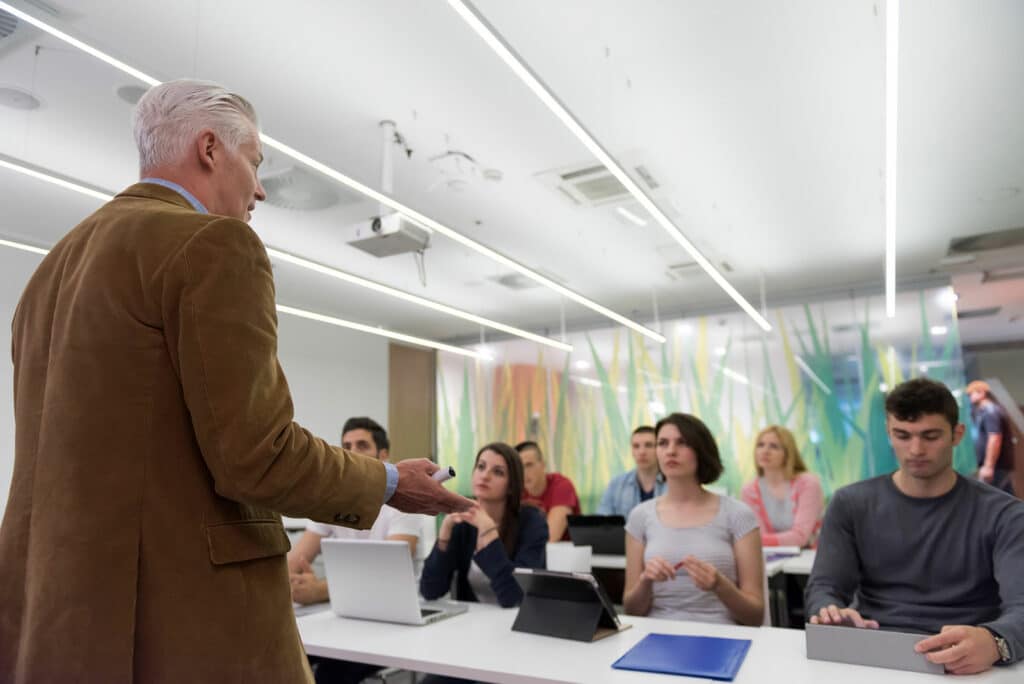In today’s digital age, e-learning has revolutionized education, providing learners with unparalleled access to a huge array of subjects and the flexibility to study from anywhere.
One of the most notable differences in online education compared to traditional classrooms is the absence of face-to-face communication. This is partly one of its attractions: learners no longer need to be at a specific place at a particular time, allowing more freedom and making it easier for those with busy schedules. But it can also present its own challenges.
This article explores the issues arising from this limitation and offers practical, in-depth solutions to create a more interactive and engaging online learning environment. Ideally, the extra elbow room provided by online courses should not undermine its quality. Luckily, there are many ways to ensure that distance learning maintains its edge. First, we’ll look at the downsides arising from the absence of face-to-face communication and then look at potential fixes.
Table of Contents
Reduced student feedback
Feedback from teachers is a core part of the learning process. Making mistakes, receiving helpful suggestions, asking questions, and having someone in tune with your progress and abilities can make or break an educational experience. But this student-instructor feedback is often lacking in online education. Unlike traditional classrooms, where students can readily ask for clarification and engage in meaningful discussions, the online environment can limit this vital feedback loop because there is often no real-time or in-person interaction.
And it is not only the help of teachers that learners might miss. Interactions between students can not only make education more fun and sociable but can also be beneficial for learning. Listening to others’ questions and comments can encourage students to engage and reflect on the lessons and course content.
When these elements are missing, the absence of feedback can lead to confusion, frustration, and a sense of detachment on the part of learners. Digital alternatives like e-mail exchanges and discussion boards can sometimes be inconsistent and less engaging than in-person classes.
Solution: Embracing alternative communication methods, like video chats, can bridge this gap. For instance, students seeking clarification on a complex topic can participate in a live video conference with peers and the teacher. These video chats allow students to ask questions in real time, share their screens to illustrate points, and engage in interactive discussions. As a result, students become more confident in their understanding of the material, which improves their academic performance.
Discussion boards and chatrooms can also be enhanced to promote peer learning and instructor feedback. Learners can be incentivized to contribute regularly, such as through posing questions on a rotational basis, and instructors can help to make them effective by facilitating with questions and comments.

Social isolation and nonverbal communication
The absence of in-person classes can lead to social isolation among online learners. Humans are inherently social creatures, and this lack of contact can negatively impact mental well-being and motivation. The lack of casual conversations, friendships, and collaborative experiences can make students feel disconnected from their classmates and alone on the learning journey. Students might also feel out of touch with their instructors, which can affect their learning outcomes.
The lack of nonverbal communication in distance learning might worsen the isolation. Even if learners can join a more interactive discussion via video call, they might be unaware of how their peers or instructors respond to comments due to limited verbal cues like eye contact and physical gestures. This can result in less engagement and feedback between peers and their instructors compared to classroom settings.
Solution: Online courses should actively encourage collaborative activities and group projects to combat social isolation. For example, students can be assigned group projects where they work together to solve complex problems or complete creative assignments. These collaborative activities foster a sense of connection and camaraderie among classmates.

Online discussions with a smaller group might also allow for more nonverbal feedback, making learners and instructors feel more comfortable and willing to engage. Through group conversations and shared goals, students build relationships and a sense of belonging, making the online learning experience more fulfilling and enjoyable.
Lack of pressure
Learners might also feel less pressured when there are no in-person classes or supervision during the course. Accountability, which naturally arises in a classroom setting, may be missing, making it easier for students to procrastinate or abandon their studies. This can be particularly troublesome because many online learners access courses from home, where the internet can be a constant source of distraction. The lack of pressure can negatively impact student retention rates, with many online learners dropping out of courses early on. Without the structure and immediate consequences of in-person classes, some learners may struggle to stay disciplined and motivated – two of the most critical determinants of success in distance learning.
Solution: While not everyone thrives under constant pressure, online courses can incorporate regular check-ins, milestones, and assessments to maintain a sense of responsibility among students. For example, regular quizzes, assignments with deadlines, and participation in discussion forums can create a structured learning environment. These assessments and activities serve as markers that keep students on track and motivated to achieve their educational goals.

Final remarks
While e-learning offers unparalleled convenience and accessibility, the absence of face-to-face communication can pose many challenges. By implementing innovative solutions like video chats, collaborative activities, and practical applications, online education can become a balanced and meaningful learning experience.
In embracing these remedies, we ensure that e-learning continues to evolve and thrive in our ever-changing educational landscape, bridging the gap between theory and practice and making it a valuable and relevant pathway to knowledge and skill development. These solutions, when applied effectively, can address the problems associated with having no in-person classes, creating a richer, more engaging, and ultimately more successful educational experience for learners worldwide.



